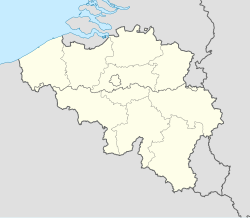Nieuwpoort (Belgium)
| Nieuwpoort | |||
|---|---|---|---|
| Municipality | |||

Belfry and city hall
|
|||
|
|||
| Location in Belgium | |||
| Coordinates: 51°07′N 02°45′E / 51.117°N 2.750°ECoordinates: 51°07′N 02°45′E / 51.117°N 2.750°E | |||
| Country | Belgium | ||
| Community | Flemish Community | ||
| Region | Flemish Region | ||
| Province | West Flanders | ||
| Arrondissement | Veurne | ||
| Government | |||
| • Mayor | Geert Vanden Broucke (CD&V) | ||
| • Governing party/ies | CD&V | ||
| Area | |||
| • Total | 31.00 km2 (11.97 sq mi) | ||
| Population (1 January 2016) | |||
| • Total | 11,379 | ||
| • Density | 370/km2 (950/sq mi) | ||
| Postal codes | 8620 | ||
| Area codes | 058 | ||
| Website | www.nieuwpoort.be | ||
Nieuwpoort (Dutch pronunciation: [ˈniupoːrt]) (West Flemish: Nieuwpôort) (French: Nieuport) is a municipality located in Flanders, one of the three regions of Belgium, and in the Flemish province of West Flanders. The municipality comprises the city of Nieuwpoort proper and the towns of Ramskapelle and Sint-Joris. On January 1, 2008, Nieuwpoort had a total population of 11,062. The total area is 31.00 km² which gives a population density of 350 inhabitants per km². The current mayor of Nieuwpoort is Rolland Crabbe (CD&V)
In Nieuwpoort, the Yser flows into the North Sea. It is also the home of a statue created by Jan Fabre called Searching for Utopia.
It obtained city rights in 1163 from Count Philip of Flanders. The Battle of Nieuwpoort, between the Dutch and the Spanish, happened here in 1600. The city was a Dunkirker base.
Painter Victor Boucquet made two of the altar-pieces for the great church in the 17th century.
The city was occupied by French forces for six years between 1757 and 1763, as part of the conditions of the Second Treaty of Versailles between France and Austria.
During the Battle of the Yser, part of the First Battle of Ypres in World War I, Hendrik Geeraert opened the sluice gates on the mouth of the river Yser twice to flood the lower lying land, thus halting the German advance.
...
Wikipedia




